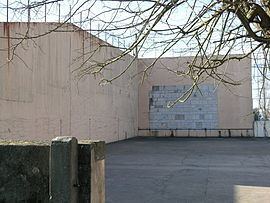Intercommunality Amikuze Area 5.29 km² | Population (2009) 307 | |
 | ||
Arbérats-Sillègue (Basque: Arberatze-Zilhekoa) is a French commune in the Pyrénées-Atlantiques department in the Nouvelle-Aquitaine region of southwestern France.
Contents
- Map of 64120 ArbC3A9rats SillC3A8gue France
- Geography
- Toponymy
- History
- Administration
- Inter communality
- Demography
- Economy
- Culture and Heritage
- Religious heritage
- Education
- Festivals
- Sports
- Leisure
- References
Map of 64120 Arb%C3%A9rats-Sill%C3%A8gue, France
The inhabitants of the commune are known as Arberaztar.
Geography
Arbérats-Sillègue is located in Mixe Country in the former Basque province of Lower Navarre, 3 km north-east of Saint-Palais and 10 km south-west of Sauveterre-de-Béarn. The D933 road from Saint-Palais to Osserain-Rivareyte in the north passes through the northern part of the commune. The D134 road passes through the east of the commune from Sussaute in the north continuing south to join the D11 road west of Domezain-Berraute. Access to the village is by country road from the western border passing through the village and going east to join the D134.
The commune is located in the Drainage basin of the Adour. The Ruisseau de Recaide forms part of the northern border flowing north-west to join the Bidouze. The Ruisseau d'Eyherachar rises north-east of the village and flows west through the commune then south forming part of the western border before joining the Bidouze just south of Aïcirits (Aïcirits-Camou-Suhast).
Toponymy
The name of the commune in basque is Arberatze-Zilhekoa. Paul Raymond indicated on page 161 of his 1863 dictionary that Sillègue in Basque was Silhecoa.
Jean-Baptiste Orpustan suggested two possible origins of the name Arbérats, both from basque: ar(r)-bera (or beratz) meaning ’fragile’ or ’friable'; or, together with the word arbel, meaning a "black stone" (Slate). Brigitte Jobbé-Duval also interpreted Arbérats as place of slate.
For Sillègue Jean-Batiste Orpustan suggested the name was a blend of the Basque word zil(h)o, meaning "hole" or "depression in the terrain" and a second element leku meaning "place".
The following table details the origins of the commune name and other names in the commune.
Sources:
Origins:
History
The village of Sillègue was merged with Arbérats on 14 April 1841.
Administration
List of Successive Mayors
(Not all data is known)
Inter-communality
The commune belongs to six inter-communal structures:
Demography
In 1350 there were 13 fires in Arbérats and 6 in Sillègue.
The fiscal census of 1412-1413, made on the orders of Charles III of Navarre, compared with that of 1551 "of men and weapons that are in this Kingdom of Navarre below the ports" reveals a demography with strong growth. The first indicated the presence at Arbérats of 7 fires, the second of 26 (24 + 2 secondary fires). The same for Sillègue: the 1412 census reported 5 fires and that of 1551 22 fires (20 + 2 secondary fires).
The census of the population of Lower Navarre in 1695 showed 40 fires at Arbérats and 20 at Sillègues.
In 2009 the commune had 307 inhabitants. The evolution of the number of inhabitants is known from the population censuses conducted in the commune since 1793. From the 21st century, a census of communes with fewer than 10,000 inhabitants is held every five years, unlike larger towns that have a sample survey every year.
Sources : Ldh/EHESS/Cassini until 1962, INSEE database from 1968 (population without double counting and municipal population from 2006) ·
Although from 1793 to 1836 Arbérats and Sillègue were separate communes, the total population for both communes is shown in the above table.
Economy
The commune is part of the Appellation d'origine contrôlée (AOC) of Ossau-iraty.
Culture and Heritage
According to the Map of the Seven Basque Provinces published in 1863 by Prince Louis-Lucien Bonaparte the Basque dialect spoken in Arbérats-Sillègue is western lower-navarrese.
Religious heritage
The Church of Saint-Laurent (1615) is registered as an historical monument.
Education
The commune has an elementary school
Festivals
The commune has a festival hall located in the centre of the village. The original building was a school and has been completely renovated.
Sports
As it was only equipped with a left wall, Arbérats-Sillègue in 2007 opened a new fronton with toilets and a Pétanque area. There is also a football field in the same complex.
Leisure
A pit dating to Roman times has been converted to a leisure park.
